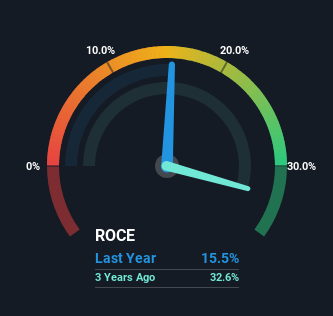Shanghai Ziyan Foods (SHSE:603057) Will Want To Turn Around Its Return Trends

If we want to find a potential multi-bagger, often there are underlying trends that can provide clues. Ideally, a business will show two trends; firstly a growing return on capital employed (ROCE) and secondly, an increasing amount of capital employed. If you see this, it typically means it's a company with a great business model and plenty of profitable reinvestment opportunities. However, after investigating Shanghai Ziyan Foods (SHSE:603057), we don't think it's current trends fit the mold of a multi-bagger.
Understanding Return On Capital Employed (ROCE)
For those that aren't sure what ROCE is, it measures the amount of pre-tax profits a company can generate from the capital employed in its business. The formula for this calculation on Shanghai Ziyan Foods is:
Return on Capital Employed = Earnings Before Interest and Tax (EBIT) ÷ (Total Assets - Current Liabilities)
0.15 = CN¥361m ÷ (CN¥3.1b - CN¥772m) (Based on the trailing twelve months to March 2024).
Thus, Shanghai Ziyan Foods has an ROCE of 15%. In absolute terms, that's a satisfactory return, but compared to the Food industry average of 7.6% it's much better.
Check out our latest analysis for Shanghai Ziyan Foods

In the above chart we have measured Shanghai Ziyan Foods' prior ROCE against its prior performance, but the future is arguably more important. If you'd like to see what analysts are forecasting going forward, you should check out our free analyst report for Shanghai Ziyan Foods .
What Does the ROCE Trend For Shanghai Ziyan Foods Tell Us?
When we looked at the ROCE trend at Shanghai Ziyan Foods, we didn't gain much confidence. Around five years ago the returns on capital were 32%, but since then they've fallen to 15%. However it looks like Shanghai Ziyan Foods might be reinvesting for long term growth because while capital employed has increased, the company's sales haven't changed much in the last 12 months. It's worth keeping an eye on the company's earnings from here on to see if these investments do end up contributing to the bottom line.
On a related note, Shanghai Ziyan Foods has decreased its current liabilities to 25% of total assets. So we could link some of this to the decrease in ROCE. What's more, this can reduce some aspects of risk to the business because now the company's suppliers or short-term creditors are funding less of its operations. Since the business is basically funding more of its operations with it's own money, you could argue this has made the business less efficient at generating ROCE.
The Key Takeaway
Bringing it all together, while we're somewhat encouraged by Shanghai Ziyan Foods' reinvestment in its own business, we're aware that returns are shrinking. Since the stock has declined 24% over the last year, investors may not be too optimistic on this trend improving either. All in all, the inherent trends aren't typical of multi-baggers, so if that's what you're after, we think you might have more luck elsewhere.
If you want to know some of the risks facing Shanghai Ziyan Foods we've found 2 warning signs (1 is a bit concerning!) that you should be aware of before investing here.
While Shanghai Ziyan Foods may not currently earn the highest returns, we've compiled a list of companies that currently earn more than 25% return on equity. Check out this free list here.
New: Manage All Your Stock Portfolios in One Place
We've created the ultimate portfolio companion for stock investors, and it's free.
• Connect an unlimited number of Portfolios and see your total in one currency
• Be alerted to new Warning Signs or Risks via email or mobile
• Track the Fair Value of your stocks
Have feedback on this article? Concerned about the content? Get in touch with us directly. Alternatively, email editorial-team (at) simplywallst.com.
This article by Simply Wall St is general in nature. We provide commentary based on historical data and analyst forecasts only using an unbiased methodology and our articles are not intended to be financial advice. It does not constitute a recommendation to buy or sell any stock, and does not take account of your objectives, or your financial situation. We aim to bring you long-term focused analysis driven by fundamental data. Note that our analysis may not factor in the latest price-sensitive company announcements or qualitative material. Simply Wall St has no position in any stocks mentioned.
About SHSE:603057
Shanghai Ziyan Foods
Engages in the research and development, production, and sales of stewed food in China.
Flawless balance sheet and fair value.

